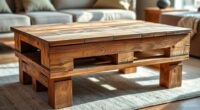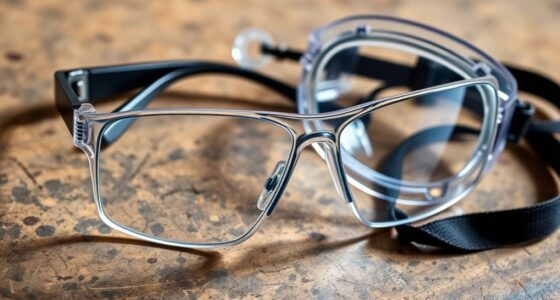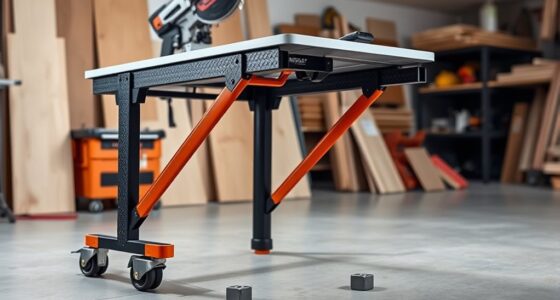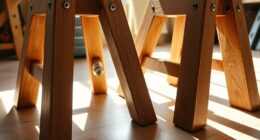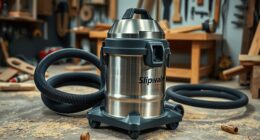To optimize your workshop lighting for safety and precision, focus on combining natural light with well-placed artificial sources. Use adjustable task lamps and LED fixtures to target work surfaces, reducing shadows and glare. Position windows and skylights to maximize daylight, and add diffusers to soften reflections. Choose lighting with a color temperature around 5000K-6500K for clarity. Proper fixture placement and regular maintenance guarantee consistent illumination. Keep exploring to discover more ways to create an ideal workspace environment.
Key Takeaways
- Combine natural light sources with layered artificial lighting to reduce shadows and improve visibility.
- Use adjustable task lamps and LED strip lights focused directly on work surfaces for precision.
- Position lighting fixtures to minimize glare, reflections, and uneven shadows, ensuring safety and accuracy.
- Select lighting with appropriate color temperature (5000K-6500K) to mimic daylight and enhance detail recognition.
- Regularly maintain and replace bulbs to sustain optimal brightness and consistent workspace illumination.

Are you making the most of your workshop lighting? Proper illumination isn’t just about brightness; it’s about creating a safe, efficient workspace that enhances your precision. To achieve this, you need to focus on task lighting and leverage natural illumination whenever possible. Task lighting is essential because it directs focused light exactly where you need it—on your work surface, tools, or specific project areas. Instead of relying solely on overhead lights, consider adding adjustable task lamps or LED strip lights that can be positioned to minimize shadows and glare. This targeted lighting reduces eye strain and helps you see fine details clearly, which is crucial for safety and accuracy. Incorporating high-quality lighting options can also improve the overall quality of your work, especially when working with detailed or delicate components. Natural illumination plays a vital role too. If your workshop has windows or skylights, make the most of daylight hours by positioning workbenches near these sources. Natural light is not only energy-efficient but also offers superior clarity for detail-oriented tasks. During the day, open curtains or blinds to flood the workspace with sunlight, which can significantly cut down on artificial lighting needs and improve overall visibility. Just be mindful of glare and direct sunlight that might cause shadows or reflections, and use diffusers or blinds to soften the light if necessary. Incorporate skylights or larger windows if you’re designing a new workshop, as these can provide consistent, high-quality natural illumination that enhances safety and reduces fatigue.
Optimize your workshop with focused task lighting to enhance safety, precision, and reduce eye strain.
Balancing task lighting with natural illumination is key. Combining the two creates a layered lighting environment that adapts throughout the day and minimizes shadows that could lead to mistakes or accidents. When natural light isn’t available or sufficient, high-quality artificial lighting becomes crucial. Use bright, energy-efficient LED fixtures that deliver consistent, flicker-free illumination, especially in areas where precision is paramount. Position these lights strategically to complement natural sources, ensuring there are no dark spots or overly bright patches that could distort your perception of colors or details. Ensuring your lighting setup includes proper positioning can greatly improve safety and accuracy in your workspace.
In addition, consider the color temperature of your lights. Cooler temperatures (around 5000K-6500K) mimic daylight and help in tasks requiring high accuracy, while warmer tones may be preferable for general ambiance. Properly installed and maintained lighting reduces shadows, glare, and contrast issues, all of which can compromise safety and precision. Regularly check and replace bulbs as needed to maintain optimal brightness. Remember, a well-lit workshop is more than just a bright space—it’s a safer, more productive environment that supports your craftsmanship and reduces the risk of errors or injuries.
Frequently Asked Questions
How Often Should Workshop Lighting Be Inspected or Maintained?
You should inspect your workshop lighting at least once every three to six months to guarantee safety and proper function. Follow a regular maintenance schedule that includes checking for flickering bulbs, damaged fixtures, or loose connections. Inspection frequency depends on usage and environment, so if your workshop sees heavy use or harsh conditions, consider more frequent checks. Staying proactive helps prevent accidents and maintains ideal lighting conditions for precision work.
What Are the Best Lighting Options for Energy Efficiency?
You should choose LED fixtures and daylight harvesting systems for the best energy efficiency. LED fixtures use less power and last longer, reducing your energy costs. Daylight harvesting automatically adjusts lighting based on natural light, saving even more energy. Combining these options guarantees your workshop is well-lit while minimizing electricity use, supporting both safety and sustainability. Regularly review and upgrade your lighting to maximize efficiency and performance.
How Can I Reduce Glare and Shadows in My Workspace?
Your workspace can shine like a beacon of clarity by tackling glare reduction and shadow minimization. Use diffused, even lighting fixtures and position lights to avoid direct glare into your eyes. Incorporate adjustable task lighting to target specific areas, and consider matte finishes on surfaces to reduce reflections. These steps will eliminate harsh shadows and glare, creating a safer, more comfortable environment where precision becomes second nature.
Are Motion Sensors Effective for Workshop Lighting?
Yes, motion sensors are effective for workshop lighting. Proper sensor placement guarantees you won’t miss any activity, while understanding different motion detection types helps you choose the best fit—like passive infrared or ultrasonic sensors. They automatically turn lights on when you enter, saving energy and improving safety. Just make sure sensors are positioned where they won’t trigger false alarms, so you maintain consistent, reliable lighting for your workspace.
How Does Lighting Color Temperature Affect Work Accuracy?
You might notice that warmer or cooler lighting influences your work accuracy more than you think. Higher color temperatures, like daylight, boost clarity and focus, helping you stay precise. Conversely, softer, warmer tones can reduce eye strain but may decrease accuracy. When choosing lighting, consider how color temperature affects your comfort and performance, because the right light can sharpen your skills and prevent mistakes, making your work both safer and more accurate.
Conclusion
So, next time you’re gazing at your dimly lit workspace, remember: a little extra light might just save your fingers—and your ego. Don’t settle for the shadows of negligence; brighten up and pretend you’re in a professional lab. After all, who wouldn’t want their workshop to look like a crime scene investigation, minus the crime? Light it up, stay safe, and enjoy the bright side of working smart. Your future self will thank you—probably with a less painful finger.

